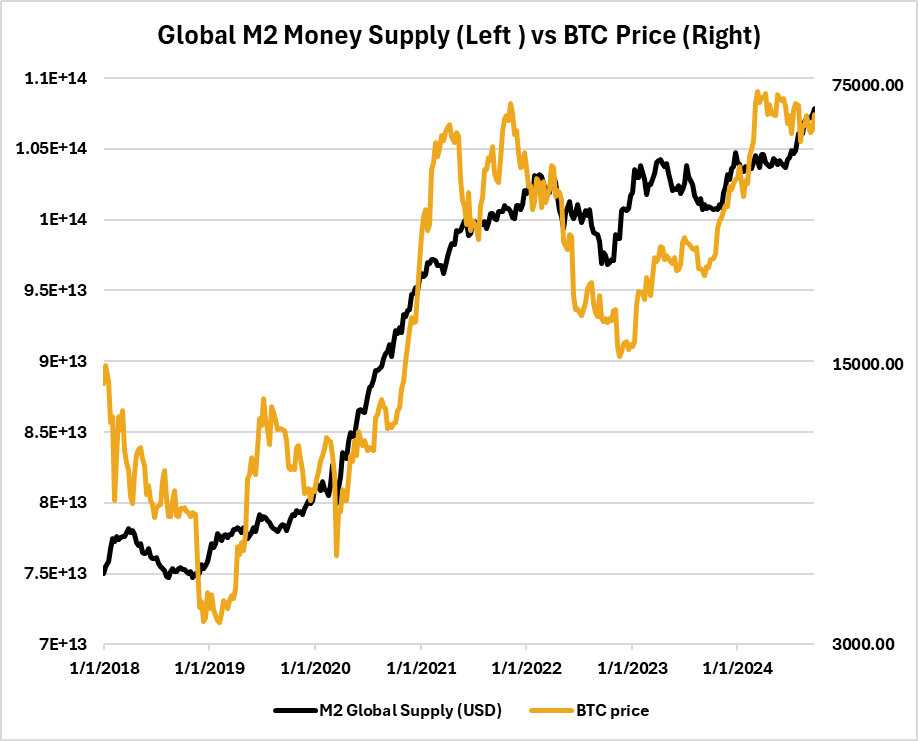
From 2020 to 2024: Comparing Bitcoin’s Past Parabolic Surge to Today’s Market
Four years ago, Bitcoin experienced a sharp surge in value, driven by a perfect storm of market factors, including the pandemic. However, this growth was not a coincidence—Bitcoin has historically followed a four-year cycle. Now, in 2024, the question arises: is the market primed for similar explosive growth?
We’ve reached a critical point in Bitcoin’s cycle where parabolic runs often occur, triggered by its halving events. These four-year cycles serve as a roadmap to Bitcoin’s price behavior, highlighting phases of accumulation, rallies, corrections, and consolidation. Understanding where we are in this cycle and how previous cycles have unfolded can help investors better navigate the market as familiar patterns resurface, particularly with the added dynamics of BTC spot ETPs and increasing global liquidity.
What is the Bitcoin Four-Year Cycle?
To better understand Bitcoin’s market behavior, it’s important to examine how the industry assesses its performance through four-year cycles, which are closely tied to Bitcoin’s halving events. These cycles have become central to understanding price movements and market trends in the broader digital asset space.
Before diving in, let’s first explain what a cycle is. Bitcoin’s four-year cycles, along with those of the broader digital asset market, are primarily driven by its halving events. These halvings occur roughly every 210,000 blocks (about every four years), and they significantly reduce the rate at which new Bitcoin is created and introduced into circulation. This reduction in supply creates a supply-demand shock that often coincides with broader economic trends such as business cycles and national elections, particularly in the U.S. and other major economies. These global events frequently inject liquidity into markets, driving the global M2 money supply to new highs. When this surge in liquidity aligns with Bitcoin's supply contraction, it typically ignites a crypto bull run.
Bitcoin’s cycles tend to follow a predictable pattern; we’ll use the 2020-2024 cycle as an example:
- Halving Event (May 2020): This is where each new cycle begins. The halving creates a supply shock, which gradually builds bullish sentiment and leads to upward price pressure.
- Post-Halving Accumulation Phase (May-October 2020): Following the halving, Bitcoin typically sees steady price increases as investors accumulate in anticipation of a future bull run, driven by the reduced supply.
- Q4 of Halving Year Parabolic Rally (October 2020-November 2021): A parabolic rally usually kicks off in Q4 of the halving year, fueled by heightened demand and market optimism. Prices often surge to new all-time highs, continuing into the following year.
- Mid-Cycle Correction (November 2021-January 2023): Around 1.5 to 2 years after the halving, a sharp correction typically occurs as the market cools, driven by profit-taking and exhaustion of the parabolic rally.
- Consolidation Phase (January 2023-June 2023): After the correction, Bitcoin enters a consolidation phase where price stabilizes and trades within a range, lasting until the next halving approaches.
- Pre-Halving Anticipation (June 2023-March 2024): As the next halving draws near, anticipation builds again, with renewed interest and accumulation, setting the stage for the next cycle's rally.
Figure 1: Global M2 Money Supply vs BTC Price

Comparing Bitcoin’s 2020-2021 Bull Run to 2024: Are We on the Verge of Another Rally?
To better understand the current market dynamics, it's helpful to compare the previous Bitcoin cycle with today's, as similar macroeconomic conditions and patterns are emerging. In the last cycle, we saw the COVID-induced selloff push Bitcoin below $4,000, only for it to rebound and surpass its previous all-time high of $20,000 by December 2020—just nine months later. During this time, DeFi emerged as one of crypto's killer use cases, attracting millions of new users with the promise of high yields in a global environment of near-zero interest rates and massive liquidity injections from stimulus efforts. This influx of participants not only boosted demand for DeFi platforms but also fueled broader Bitcoin hype, driving prices higher as new capital flowed into the growing digital asset ecosystem. Nearly a year after breaking its previous high, Bitcoin reached its cycle peak in November 2021, marking the top of that bull market.
Figure 2: BTC Price 2023-Present vs BTC Price 2019-2021

The 2020-2021 bull run was fueled by a perfect storm of factors driving risk assets, including digital assets. The COVID-19 pandemic and global lockdowns triggered a surge in retail trading, while massive government stimulus and quantitative easing flooded markets with liquidity. Investors, seeking yield and inflation hedges, increasingly turned to Bitcoin, which also benefited from rising institutional interest. Key events like the launch of Bitcoin futures ETFs and Coinbase’s direct listing in April 2021 further cemented mainstream adoption, pushing Bitcoin to new heights.
However, these milestones—particularly the Coinbase IPO and Bitcoin futures ETFs—also marked the peak of the cycle. The excitement surrounding these events brought a flood of new retail investors, driving Bitcoin prices to unsustainable highs and signaling market exhaustion.
The 2020-2021 bull run was not limited to Bitcoin; it was part of a broader global rally across multiple asset classes, including equities, real estate, and commodities, driven by unprecedented liquidity and low interest rates. Much like the current market dynamics, the 2020-2021 bull run was characterized by a synchronized global surge across financial markets, reflecting a risk-on sentiment that extended well beyond just Bitcoin. Similarly, this cycle mirrors the last for many of the same reasons, with one key difference...enter BTC spot ETPs.
For the first time in Bitcoin’s history, BTC reached a new all-time high before the halving. On March 11, just two months after Bitcoin spot ETPs began trading, Bitcoin surged past its previous high of $69,000, closing just below $72,000. The launch of spot ETPs opened the floodgates for both institutional and retail capital, providing a more accessible and registered entry point for large-scale investors and everyday traders alike. This influx of capital created substantial buying pressure, pushing prices beyond previous highs as the market anticipated further institutional adoption. The introduction of spot ETPs has sparked debate about whether Bitcoin’s traditional four-year cycle is still intact, with some questioning if this pre-halving all-time high disrupts the established pattern. Yet, despite these developments, Bitcoin seems to be following its historical cycle, with familiar seasonal trends unfolding. Now, with October—affectionately known as "Uptober" in the crypto community—upon us, the stage is set for the next phase of the cycle to play out.
Queue Uptober
October has historically been a strong month for Bitcoin and the broader digital asset market, earning the nickname "Uptober" among crypto enthusiasts. Nine out of the 13 Octobers since Bitcoin began trading have seen positive returns. During halving years, October often kicks off Bitcoin’s Q4 rally, which can extend into the following year. This was evident in October 2016, when Bitcoin soared from $600 to nearly $20,000 by Q4 2017, and again in October 2020, when Bitcoin jumped from $11,000 to over $69,000 by Q4 2021. With similar macro conditions—such as global rate cuts and a fresh wave of crypto adoption—there’s speculation that history could repeat itself.
Figure 3: BTC Monthly Returns 2013-Present

In the last cycle, new use cases like DeFi, NFTs, and Gaming/Metaverse attracted millions of users. Celebrities like Justin Bieber and Eminem spent over $1 million on Bored Ape NFTs, while investors flocked to DeFi for high APYs. This cycle, the attention is shifting toward community tokens and prediction markets, which are onboarding millions of users and gaining mainstream attention. The introduction of ETH and BTC spot ETPs is also offering a registered entry point for institutions and retail investors, making crypto more accessible. Layer 2 solutions are improving Ethereum's scalability and affordability, while projects focus on enhancing the user experience, driving more users on-chain, and boosting total value locked (TVL) [the crypto native version of assets under management] in the ecosystem.
Much like the previous cycle, the global macroeconomic backdrop is increasingly favorable for risk assets. Central banks, including China’s, are implementing quantitative easing, while the U.S. has begun its rate-cutting cycle with a 50bps reduction, creating an environment of lower borrowing costs and increased liquidity. Historically, these conditions have driven investors toward higher-return assets like Bitcoin, setting the stage for another potential bull run as capital flows into the digital asset space.


.svg)



_logo.svg)

.svg.png)